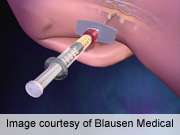Dual epidural analgesia most effective for scoliosis surgery

(HealthDay)—Dual continuous epidural analgesia (CEA) is the most effective pain control method following surgery for adolescent idiopathic scoliosis, according to a study published in the Sept. 1 issue of Spine.
Joshua W.B. Klatt, M.D., from the University of Utah in Salt Lake City, and colleagues randomized 66 patients with adolescent idiopathic scoliosis to patient-controlled analgesia (PCA), single CEA, or double CEA. Analyzed data included postoperative pain scores, side effects, complications, and use of breakthrough medication. Recovery times were assessed by several measurements, including hospitalization, times to first bowel movement, and days to walk and climb stairs.
The researchers found that double CEA most effectively controlled pain intensity, compared to PCA and a single CEA. PCA and single CEA groups similarly controlled pain. Single CEA had the fewest side effects, with an average of 2.55 side effects per patient. Pruritis, constipation, and nausea constituted the majority of side effects. No late onset neurological events were seen in any patients.
"On the basis [of] these findings, we now routinely use the double CEA technique for all patients having surgery for adolescent idiopathic scoliosis," Klatt and colleagues conclude.
Copyright © 2013 HealthDay. All rights reserved.





















